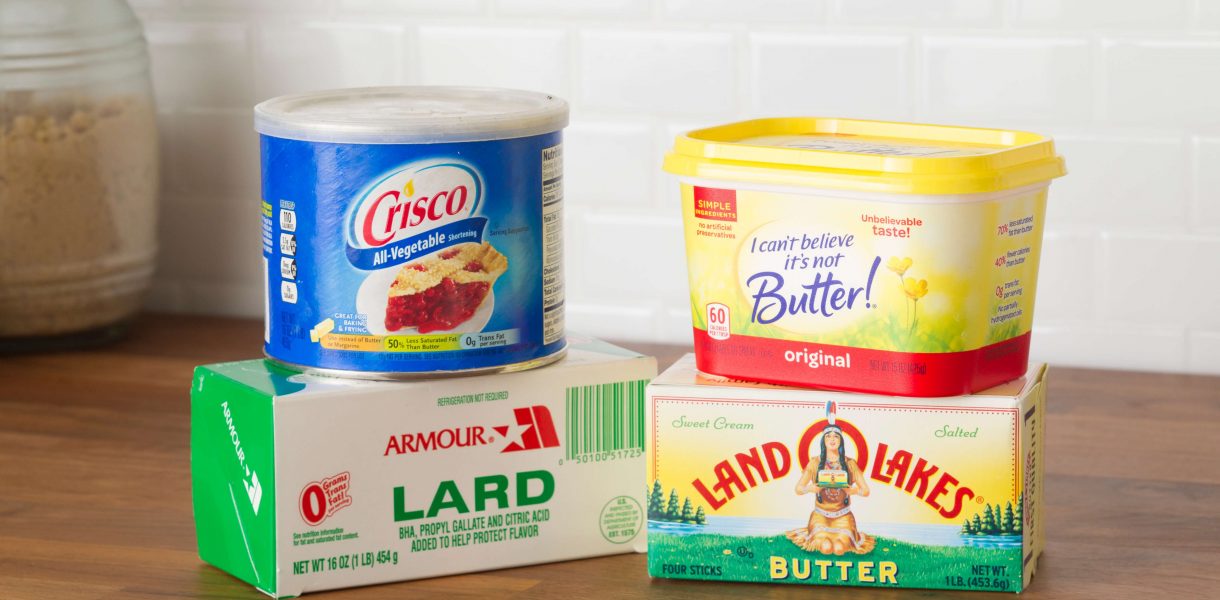
What is shortening exactly?
Shortening refers to any room temperature solid fat such as hydrogenated vegetable oil, margarine, butter, tallow, and lard. Most often when seen in a recipe it is referring to hydrogenated vegetable oil which commonly goes by the brand name Crisco. Shortening is used to create short or shortened dough in recipes because it inhibits gluten bonds which create elasticity meaning dough made with a shortening will result in a crumby texture.
Many of these shortenings can be used interchangeably, but can alter the look or taste of the final product. You can make recipes as written or substitute the shortening listed for another option. Sometimes this small change will result in a better end product and other times it will cause the recipe to not work out as expected.
Below we will explore some of the different types of shortening.
Crisco (hydrogenated vegetable oil)

Crisco is made of hydrogenated vegetable oil. The hydrogenation of fats was first patented by Wilhelm Normann in 1902. Five years later a Chemist, Edwin Cuno Kayser, who had used Normann’s process at a soap manufacturing plant moved to the United States and sold it to Procter & Gamble. When they used the process on cottonseed oil it resembled lard so they began to sell it as a lard substitute instead of in soap production. “Crisco” got it’s name as a condensed version of “crystalized cottonseed oil”.
Oleo(margarine)
Oleo is another shortening that you may see called out in many old recipes. It comes from the word oleomargarine which you may know today as margarine. It was created by Hippolyte Mège-Mouriès as a butter and animal fat substitute in 1869 as part of a challenge Emperor Napoleon III created in order to feed the military and poor. Oleomargarine was originally a mixture of of vegetable oils and animal fats, but during World War II skim milk was substituted for the animal fats due to shortages and rationing. During this time they began to add yellow food coloring so that the oleomargarine would more resemble butter.
Butter and Ghee

Butter is a semi-solid fat made from the fats in the cream of animal milk. It is most often made from cow milk, but can be made from any mammal milk with a high enough fat content. You may also see butter from goats and sheep in specialty stores. We even have a camel dairy locally that sells camel dairy products.
The cream is churned which causes the fat in the cream to stick together leaving you with butter and the remaining buttermilk. Some companies also add salt and/or food coloring to the butter.
Ghee is made by melting butter and removing the milk solids and water leaving only the butter fat. It is a golden yellow liquid fat and some manufacturers say that it is shelf stable.
Tallow

Tallow is the purified fat from beef, and sometimes sheep, which is solid at room temperature. It is shelf stable and can be stored for long periods without refrigeration in an air tight container. It is more popularly used in savory dishes and as a frying fat, but can be used in baking to create a wonderful flakiness in pastry dough.
Lard

Lard is the semi-solid purified fat from pigs. It has much of the same properties as tallow, such as its storage and uses. Although when rendered properly it is said to be tasteless and odorless.

